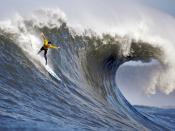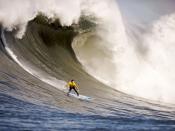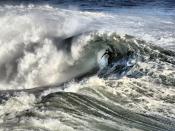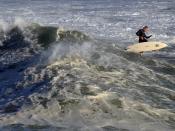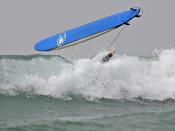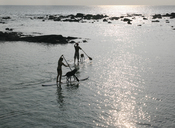I don't believe another feeling could be compared to standing up on your surfboard and guiding it with your feet in a jumping, collapsing gyre of water. Imagine a moment when you get out of your car, see a beautiful sunlit ocean, easy rolling waves, other surfers, and your chest will pound with an undeniable urge to go out and join them. The thrills, the speed, and the fun all exist and you'll know it. You'll feel it. But in order to obtain this paradise you need to learn how to surf. So let's get started! First and foremost is your equipment. Luckily for you surfing isn't as equipment heavy as opposed to skiing or windsurfing. You need five basic things and they are a surfboard, a leash, a wetsuit, some wax, and of course sun block (unless you live in areas other than Seattle or England, it is often necessary).
Once you've done your research and got all your equipment, get a partner because it reduces your chances of being eaten by a shark, and that's always good! A partner will give you moral support, keep you stoked when you feel frustrated, keep you from sleeping in when the surf is good, talk you into paddling out when it's big, and most importantly just being a friend. You can either find someone experienced to teach you how to surf or find someone else who wants to learn and you can teach each other. I suggest the second approach (that's how I learned) because more than likely when someone is better than the other, one person won't be having a fun session.
Now that you have your equipment and have a bro (i.e. partner) the next thing you should learn are the rules of surfing. Yes, surfers have rules, and to be safe you should learn them and make these rules a part of your life. First rule is the Thou Shalt Not Drop-In Rule and probably the most important. Dropping-in is taking off on a wave when someone is already riding it. Never drop-in on another surfer! Second rule is the Wave Ownership or My Wave Rule and it is simply that the first person paddling out to the wave or closest to the breaking part has the right of way. Third rule is the Eat It Rule. When paddling out and must get over a wave someone is riding, paddle behind him or her on the white water side. You'll get battered, but take comfort that they would do the same for you. Surfers are generally nice people but when you break a rule, they just might break you.
You have your equipment, your bro, and you know the rules every surfer lives by, so now the question is where you should practice and gain experience. Ask around when shopping for your equipment for a good break for beginners. Ideal breaks for beginners look crumbly and slow. Try to find small waves and a sandy beach; you'll be walking around a lot.
Before you learn anything else, learn how to paddle. Your paddle stroke should essentially be a freestyle/crawl-swimming stroke. For long paddles, keep your head and neck down, conserve your energy and prevent craning your neck. Keep your feet together and use them for balance and kick like crazy when going after a wave. But most of all practice your form. Look at the experienced surfers' forms and learn from them, even ask them for tips. Before paddling out watch the surf for a while. Watch what people are doing, where they're sitting, and where they paddle out. Everything is safer that way.
You've noted where other people head out. Wax your board, or in surfer slang your stick, and head down to that spot. Before you put on your leash on shore, decide whether you're a regular foot (left foot forward) or a goofy. Once you've determined that put your leash on your back leg. Walk your board out until the water is waist deep and hop on. Position yourself in the center of the board so that the nose is just barely out of the water. Now head out and remember your paddling techniques and your manners.
Your first, of many hurdles, in learning how to surf is catching your first wave. The wave knowledge of when to start paddling, how fast, how much to arch your back, and when to get to your feet are things no one can teach you. They will come with practice and with patience. One tip I will offer is that when trying to stand up, stand up. Don't get to your knees first, that leads to kneeboarding, a curable illness.
Let's just say you've mastered standing, so now, your job is to lean and move on the board to aim along the wave. If you lean just a little to either side of the board, it turns. Experiment with walking up and down the deck of your board and steering your board with your feet. As you gain experience you're going to learn, and discover, some phenomenal things about how your surfboard performs, things you possibly can't understand yet. But once you start to understand your discoveries you will be on your way to surfing nirvana.
